Training and Learning: Case Study of Larry's Restaurant Experience
VerifiedAdded on 2022/10/01
|8
|2245
|279
Case Study
AI Summary
This case study analyzes a scenario where a high school student, Larry, starts a summer job as a cook at a restaurant and faces numerous challenges due to inadequate training and a lack of supervision. The assignment explores issues like the absence of effective communication, incompetence in cooperating with the supervisor, and the inability to handle workplace pressure. It discusses the importance of a buddy system and seniority in the workplace, highlighting the role of senior employees in guiding and motivating new hires. The study further differentiates between good employees and good trainers, outlining essential traits of effective trainers, such as communication skills, understanding training objectives, leadership abilities, and a focus on continuous learning. The case study identifies five factors for effective training plans and emphasizes the significance of communication, cooperation, and encouragement in the buddy system. The student has referenced various research papers and studies to support the analysis and recommendations.
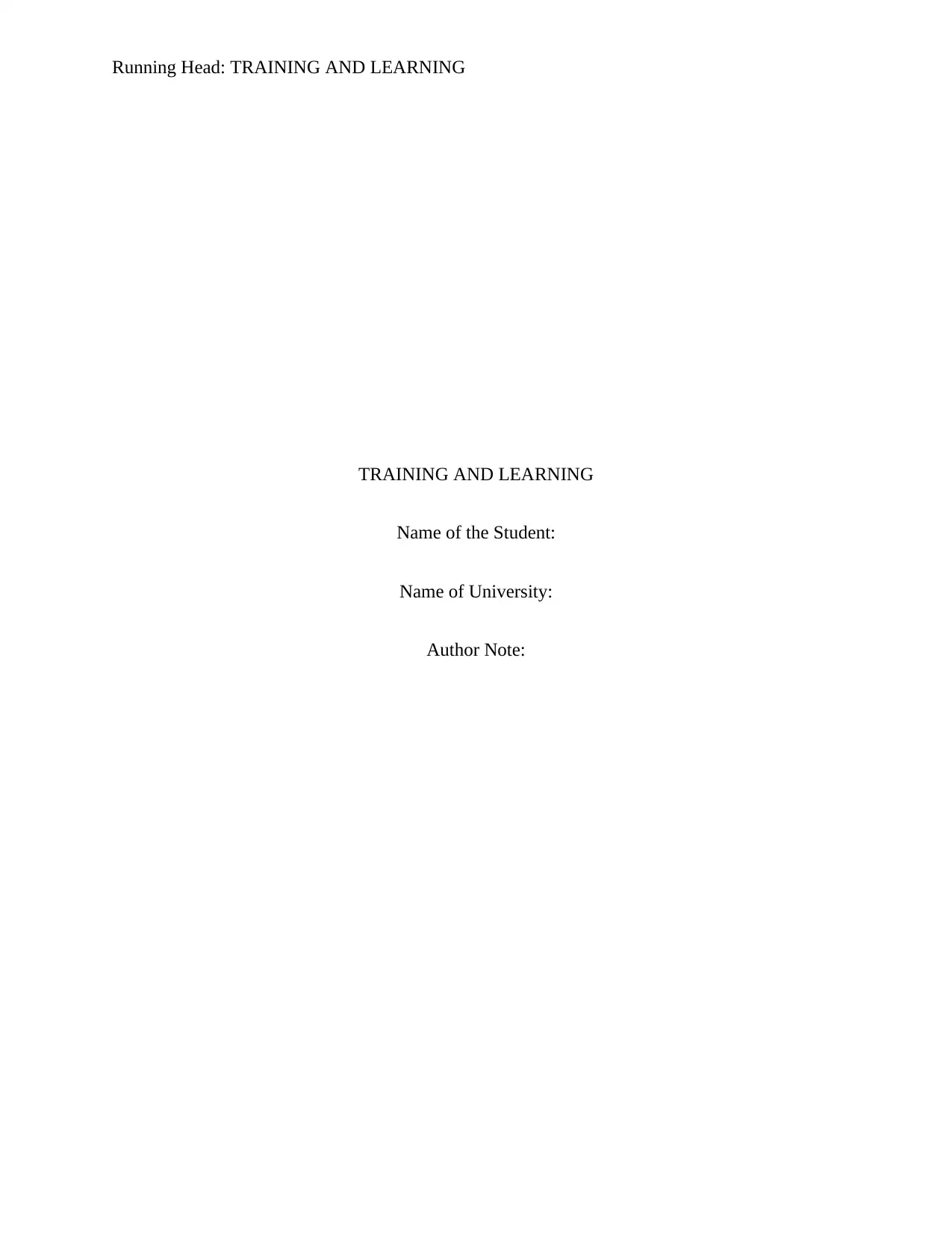
Running Head: TRAINING AND LEARNING
TRAINING AND LEARNING
Name of the Student:
Name of University:
Author Note:
TRAINING AND LEARNING
Name of the Student:
Name of University:
Author Note:
Paraphrase This Document
Need a fresh take? Get an instant paraphrase of this document with our AI Paraphraser
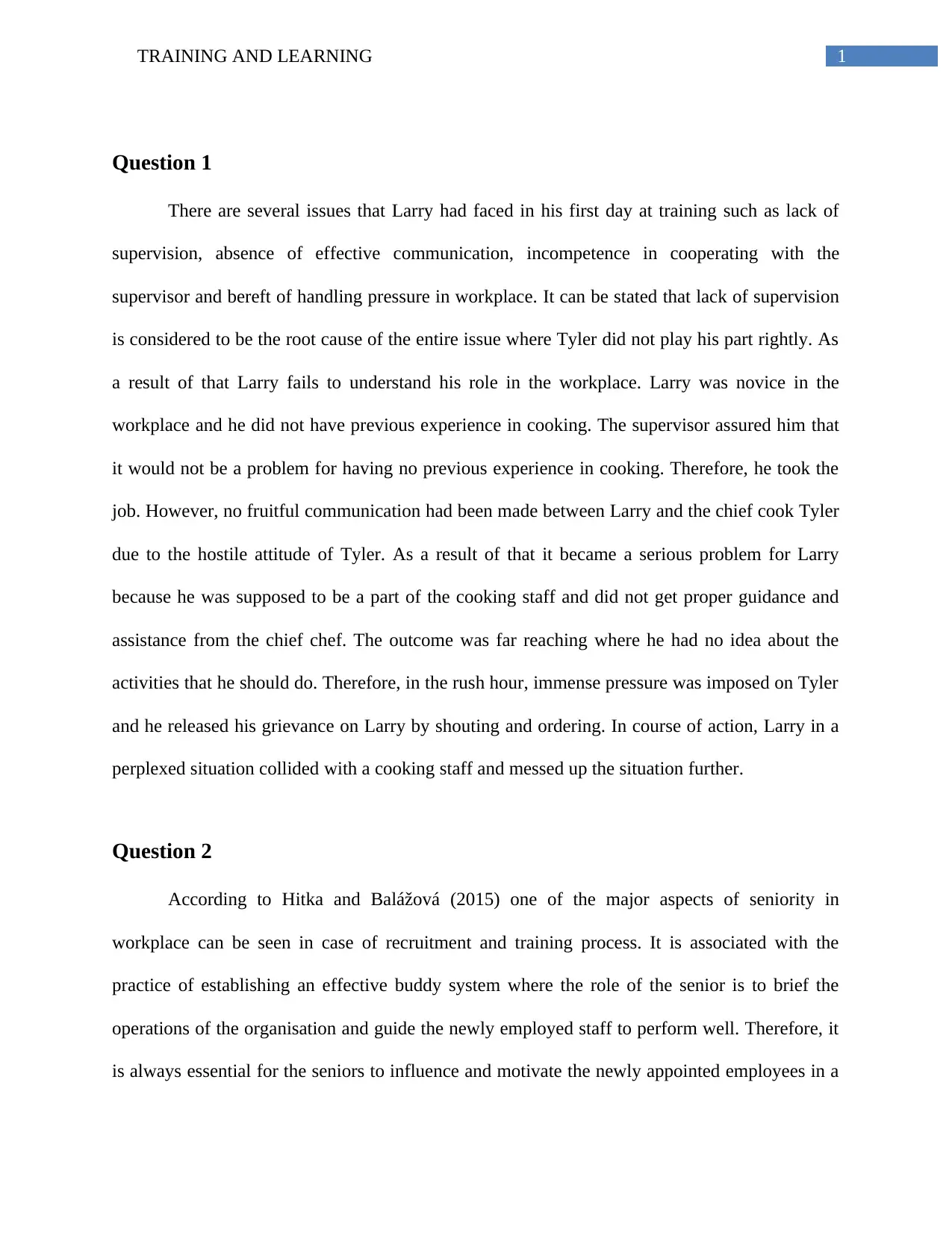
1TRAINING AND LEARNING
Question 1
There are several issues that Larry had faced in his first day at training such as lack of
supervision, absence of effective communication, incompetence in cooperating with the
supervisor and bereft of handling pressure in workplace. It can be stated that lack of supervision
is considered to be the root cause of the entire issue where Tyler did not play his part rightly. As
a result of that Larry fails to understand his role in the workplace. Larry was novice in the
workplace and he did not have previous experience in cooking. The supervisor assured him that
it would not be a problem for having no previous experience in cooking. Therefore, he took the
job. However, no fruitful communication had been made between Larry and the chief cook Tyler
due to the hostile attitude of Tyler. As a result of that it became a serious problem for Larry
because he was supposed to be a part of the cooking staff and did not get proper guidance and
assistance from the chief chef. The outcome was far reaching where he had no idea about the
activities that he should do. Therefore, in the rush hour, immense pressure was imposed on Tyler
and he released his grievance on Larry by shouting and ordering. In course of action, Larry in a
perplexed situation collided with a cooking staff and messed up the situation further.
Question 2
According to Hitka and Balážová (2015) one of the major aspects of seniority in
workplace can be seen in case of recruitment and training process. It is associated with the
practice of establishing an effective buddy system where the role of the senior is to brief the
operations of the organisation and guide the newly employed staff to perform well. Therefore, it
is always essential for the seniors to influence and motivate the newly appointed employees in a
Question 1
There are several issues that Larry had faced in his first day at training such as lack of
supervision, absence of effective communication, incompetence in cooperating with the
supervisor and bereft of handling pressure in workplace. It can be stated that lack of supervision
is considered to be the root cause of the entire issue where Tyler did not play his part rightly. As
a result of that Larry fails to understand his role in the workplace. Larry was novice in the
workplace and he did not have previous experience in cooking. The supervisor assured him that
it would not be a problem for having no previous experience in cooking. Therefore, he took the
job. However, no fruitful communication had been made between Larry and the chief cook Tyler
due to the hostile attitude of Tyler. As a result of that it became a serious problem for Larry
because he was supposed to be a part of the cooking staff and did not get proper guidance and
assistance from the chief chef. The outcome was far reaching where he had no idea about the
activities that he should do. Therefore, in the rush hour, immense pressure was imposed on Tyler
and he released his grievance on Larry by shouting and ordering. In course of action, Larry in a
perplexed situation collided with a cooking staff and messed up the situation further.
Question 2
According to Hitka and Balážová (2015) one of the major aspects of seniority in
workplace can be seen in case of recruitment and training process. It is associated with the
practice of establishing an effective buddy system where the role of the senior is to brief the
operations of the organisation and guide the newly employed staff to perform well. Therefore, it
is always essential for the seniors to influence and motivate the newly appointed employees in a
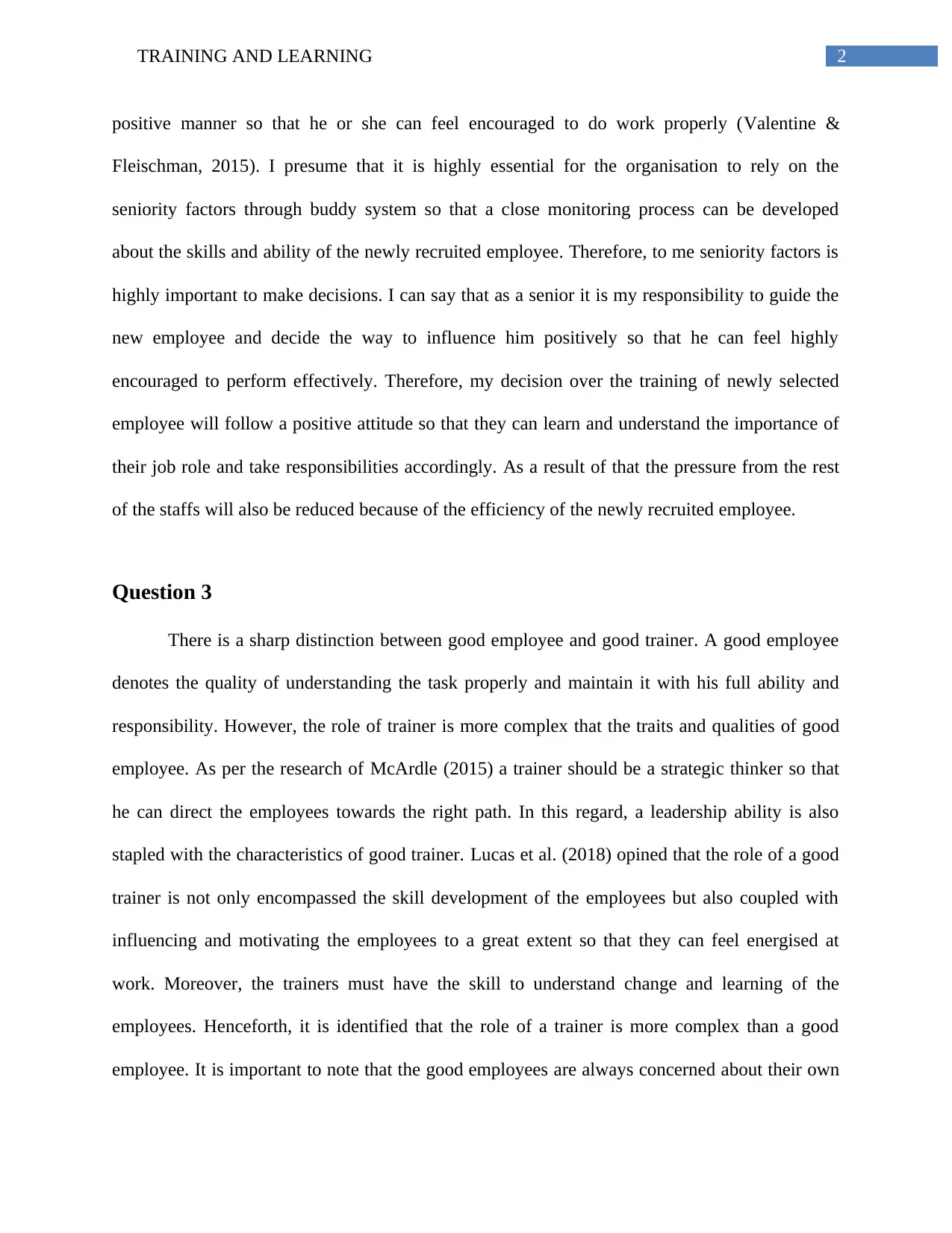
2TRAINING AND LEARNING
positive manner so that he or she can feel encouraged to do work properly (Valentine &
Fleischman, 2015). I presume that it is highly essential for the organisation to rely on the
seniority factors through buddy system so that a close monitoring process can be developed
about the skills and ability of the newly recruited employee. Therefore, to me seniority factors is
highly important to make decisions. I can say that as a senior it is my responsibility to guide the
new employee and decide the way to influence him positively so that he can feel highly
encouraged to perform effectively. Therefore, my decision over the training of newly selected
employee will follow a positive attitude so that they can learn and understand the importance of
their job role and take responsibilities accordingly. As a result of that the pressure from the rest
of the staffs will also be reduced because of the efficiency of the newly recruited employee.
Question 3
There is a sharp distinction between good employee and good trainer. A good employee
denotes the quality of understanding the task properly and maintain it with his full ability and
responsibility. However, the role of trainer is more complex that the traits and qualities of good
employee. As per the research of McArdle (2015) a trainer should be a strategic thinker so that
he can direct the employees towards the right path. In this regard, a leadership ability is also
stapled with the characteristics of good trainer. Lucas et al. (2018) opined that the role of a good
trainer is not only encompassed the skill development of the employees but also coupled with
influencing and motivating the employees to a great extent so that they can feel energised at
work. Moreover, the trainers must have the skill to understand change and learning of the
employees. Henceforth, it is identified that the role of a trainer is more complex than a good
employee. It is important to note that the good employees are always concerned about their own
positive manner so that he or she can feel encouraged to do work properly (Valentine &
Fleischman, 2015). I presume that it is highly essential for the organisation to rely on the
seniority factors through buddy system so that a close monitoring process can be developed
about the skills and ability of the newly recruited employee. Therefore, to me seniority factors is
highly important to make decisions. I can say that as a senior it is my responsibility to guide the
new employee and decide the way to influence him positively so that he can feel highly
encouraged to perform effectively. Therefore, my decision over the training of newly selected
employee will follow a positive attitude so that they can learn and understand the importance of
their job role and take responsibilities accordingly. As a result of that the pressure from the rest
of the staffs will also be reduced because of the efficiency of the newly recruited employee.
Question 3
There is a sharp distinction between good employee and good trainer. A good employee
denotes the quality of understanding the task properly and maintain it with his full ability and
responsibility. However, the role of trainer is more complex that the traits and qualities of good
employee. As per the research of McArdle (2015) a trainer should be a strategic thinker so that
he can direct the employees towards the right path. In this regard, a leadership ability is also
stapled with the characteristics of good trainer. Lucas et al. (2018) opined that the role of a good
trainer is not only encompassed the skill development of the employees but also coupled with
influencing and motivating the employees to a great extent so that they can feel energised at
work. Moreover, the trainers must have the skill to understand change and learning of the
employees. Henceforth, it is identified that the role of a trainer is more complex than a good
employee. It is important to note that the good employees are always concerned about their own
⊘ This is a preview!⊘
Do you want full access?
Subscribe today to unlock all pages.

Trusted by 1+ million students worldwide
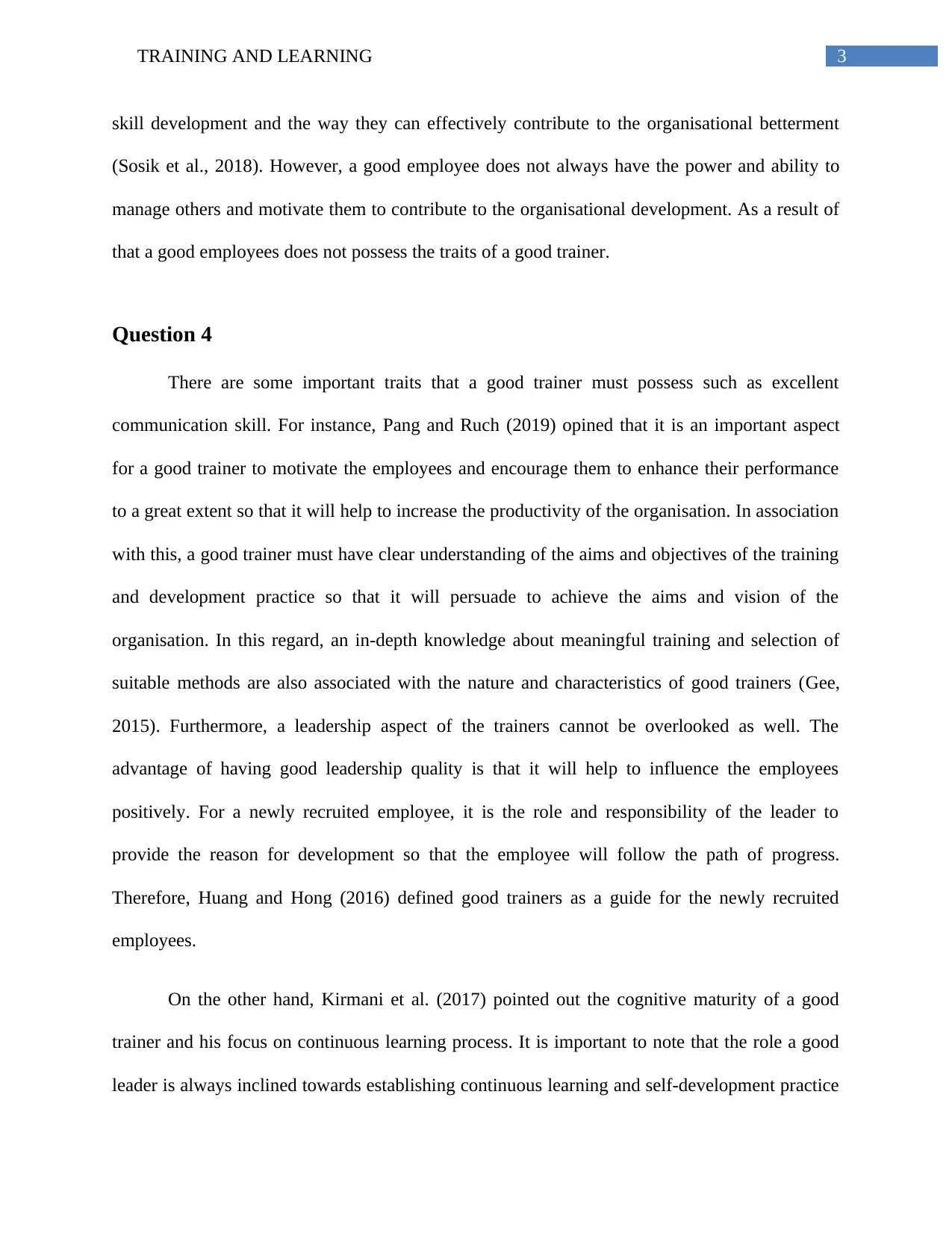
3TRAINING AND LEARNING
skill development and the way they can effectively contribute to the organisational betterment
(Sosik et al., 2018). However, a good employee does not always have the power and ability to
manage others and motivate them to contribute to the organisational development. As a result of
that a good employees does not possess the traits of a good trainer.
Question 4
There are some important traits that a good trainer must possess such as excellent
communication skill. For instance, Pang and Ruch (2019) opined that it is an important aspect
for a good trainer to motivate the employees and encourage them to enhance their performance
to a great extent so that it will help to increase the productivity of the organisation. In association
with this, a good trainer must have clear understanding of the aims and objectives of the training
and development practice so that it will persuade to achieve the aims and vision of the
organisation. In this regard, an in-depth knowledge about meaningful training and selection of
suitable methods are also associated with the nature and characteristics of good trainers (Gee,
2015). Furthermore, a leadership aspect of the trainers cannot be overlooked as well. The
advantage of having good leadership quality is that it will help to influence the employees
positively. For a newly recruited employee, it is the role and responsibility of the leader to
provide the reason for development so that the employee will follow the path of progress.
Therefore, Huang and Hong (2016) defined good trainers as a guide for the newly recruited
employees.
On the other hand, Kirmani et al. (2017) pointed out the cognitive maturity of a good
trainer and his focus on continuous learning process. It is important to note that the role a good
leader is always inclined towards establishing continuous learning and self-development practice
skill development and the way they can effectively contribute to the organisational betterment
(Sosik et al., 2018). However, a good employee does not always have the power and ability to
manage others and motivate them to contribute to the organisational development. As a result of
that a good employees does not possess the traits of a good trainer.
Question 4
There are some important traits that a good trainer must possess such as excellent
communication skill. For instance, Pang and Ruch (2019) opined that it is an important aspect
for a good trainer to motivate the employees and encourage them to enhance their performance
to a great extent so that it will help to increase the productivity of the organisation. In association
with this, a good trainer must have clear understanding of the aims and objectives of the training
and development practice so that it will persuade to achieve the aims and vision of the
organisation. In this regard, an in-depth knowledge about meaningful training and selection of
suitable methods are also associated with the nature and characteristics of good trainers (Gee,
2015). Furthermore, a leadership aspect of the trainers cannot be overlooked as well. The
advantage of having good leadership quality is that it will help to influence the employees
positively. For a newly recruited employee, it is the role and responsibility of the leader to
provide the reason for development so that the employee will follow the path of progress.
Therefore, Huang and Hong (2016) defined good trainers as a guide for the newly recruited
employees.
On the other hand, Kirmani et al. (2017) pointed out the cognitive maturity of a good
trainer and his focus on continuous learning process. It is important to note that the role a good
leader is always inclined towards establishing continuous learning and self-development practice
Paraphrase This Document
Need a fresh take? Get an instant paraphrase of this document with our AI Paraphraser
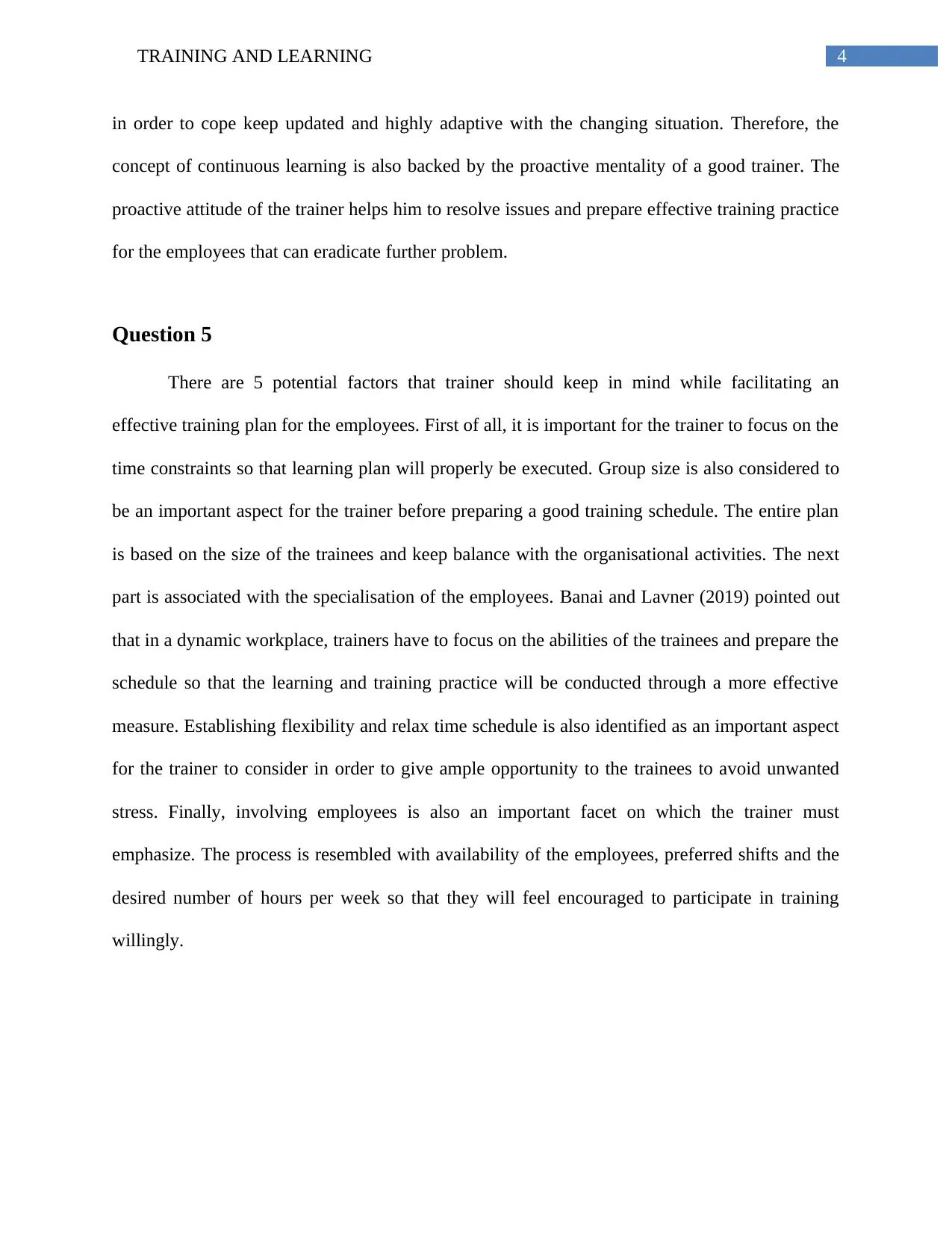
4TRAINING AND LEARNING
in order to cope keep updated and highly adaptive with the changing situation. Therefore, the
concept of continuous learning is also backed by the proactive mentality of a good trainer. The
proactive attitude of the trainer helps him to resolve issues and prepare effective training practice
for the employees that can eradicate further problem.
Question 5
There are 5 potential factors that trainer should keep in mind while facilitating an
effective training plan for the employees. First of all, it is important for the trainer to focus on the
time constraints so that learning plan will properly be executed. Group size is also considered to
be an important aspect for the trainer before preparing a good training schedule. The entire plan
is based on the size of the trainees and keep balance with the organisational activities. The next
part is associated with the specialisation of the employees. Banai and Lavner (2019) pointed out
that in a dynamic workplace, trainers have to focus on the abilities of the trainees and prepare the
schedule so that the learning and training practice will be conducted through a more effective
measure. Establishing flexibility and relax time schedule is also identified as an important aspect
for the trainer to consider in order to give ample opportunity to the trainees to avoid unwanted
stress. Finally, involving employees is also an important facet on which the trainer must
emphasize. The process is resembled with availability of the employees, preferred shifts and the
desired number of hours per week so that they will feel encouraged to participate in training
willingly.
in order to cope keep updated and highly adaptive with the changing situation. Therefore, the
concept of continuous learning is also backed by the proactive mentality of a good trainer. The
proactive attitude of the trainer helps him to resolve issues and prepare effective training practice
for the employees that can eradicate further problem.
Question 5
There are 5 potential factors that trainer should keep in mind while facilitating an
effective training plan for the employees. First of all, it is important for the trainer to focus on the
time constraints so that learning plan will properly be executed. Group size is also considered to
be an important aspect for the trainer before preparing a good training schedule. The entire plan
is based on the size of the trainees and keep balance with the organisational activities. The next
part is associated with the specialisation of the employees. Banai and Lavner (2019) pointed out
that in a dynamic workplace, trainers have to focus on the abilities of the trainees and prepare the
schedule so that the learning and training practice will be conducted through a more effective
measure. Establishing flexibility and relax time schedule is also identified as an important aspect
for the trainer to consider in order to give ample opportunity to the trainees to avoid unwanted
stress. Finally, involving employees is also an important facet on which the trainer must
emphasize. The process is resembled with availability of the employees, preferred shifts and the
desired number of hours per week so that they will feel encouraged to participate in training
willingly.
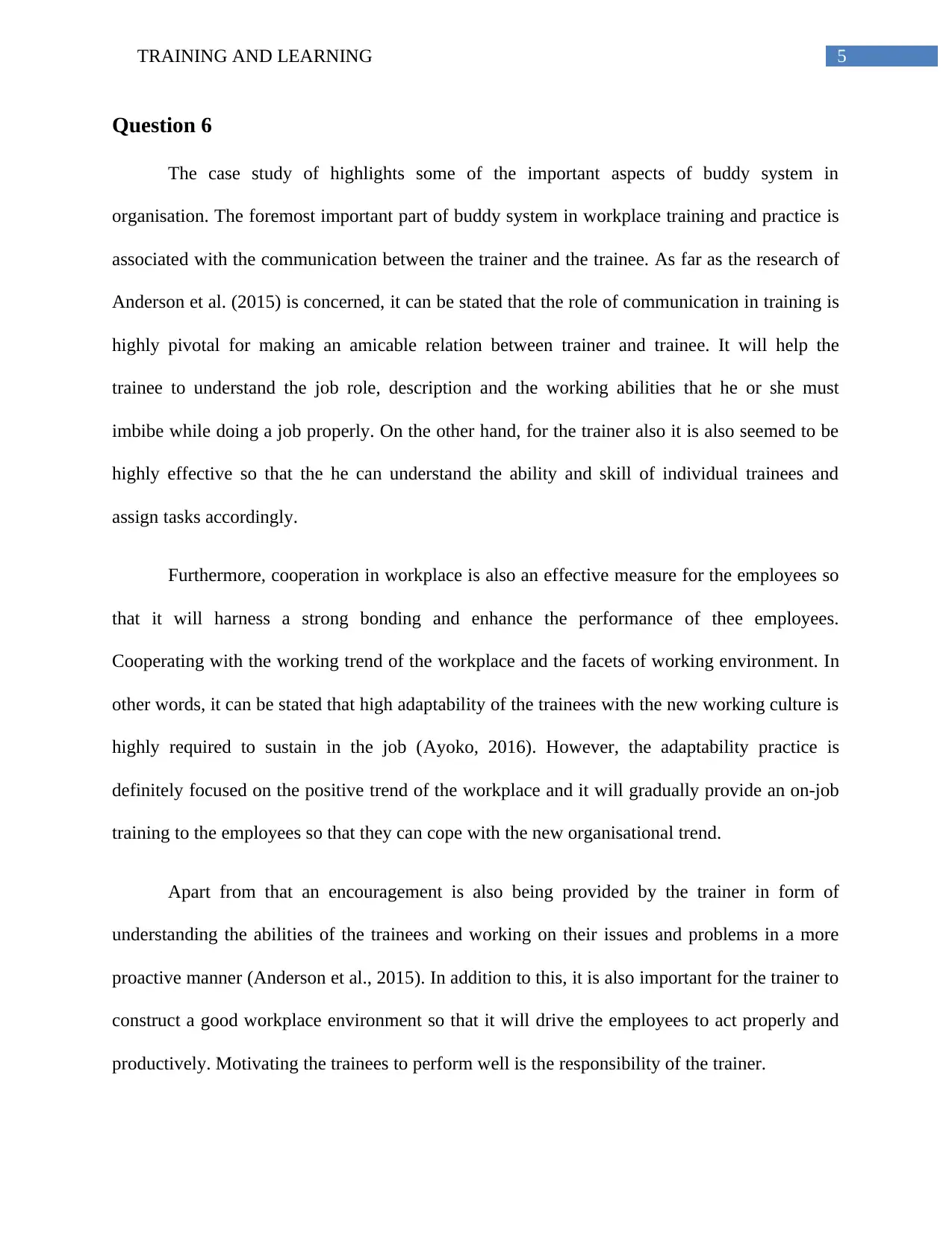
5TRAINING AND LEARNING
Question 6
The case study of highlights some of the important aspects of buddy system in
organisation. The foremost important part of buddy system in workplace training and practice is
associated with the communication between the trainer and the trainee. As far as the research of
Anderson et al. (2015) is concerned, it can be stated that the role of communication in training is
highly pivotal for making an amicable relation between trainer and trainee. It will help the
trainee to understand the job role, description and the working abilities that he or she must
imbibe while doing a job properly. On the other hand, for the trainer also it is also seemed to be
highly effective so that the he can understand the ability and skill of individual trainees and
assign tasks accordingly.
Furthermore, cooperation in workplace is also an effective measure for the employees so
that it will harness a strong bonding and enhance the performance of thee employees.
Cooperating with the working trend of the workplace and the facets of working environment. In
other words, it can be stated that high adaptability of the trainees with the new working culture is
highly required to sustain in the job (Ayoko, 2016). However, the adaptability practice is
definitely focused on the positive trend of the workplace and it will gradually provide an on-job
training to the employees so that they can cope with the new organisational trend.
Apart from that an encouragement is also being provided by the trainer in form of
understanding the abilities of the trainees and working on their issues and problems in a more
proactive manner (Anderson et al., 2015). In addition to this, it is also important for the trainer to
construct a good workplace environment so that it will drive the employees to act properly and
productively. Motivating the trainees to perform well is the responsibility of the trainer.
Question 6
The case study of highlights some of the important aspects of buddy system in
organisation. The foremost important part of buddy system in workplace training and practice is
associated with the communication between the trainer and the trainee. As far as the research of
Anderson et al. (2015) is concerned, it can be stated that the role of communication in training is
highly pivotal for making an amicable relation between trainer and trainee. It will help the
trainee to understand the job role, description and the working abilities that he or she must
imbibe while doing a job properly. On the other hand, for the trainer also it is also seemed to be
highly effective so that the he can understand the ability and skill of individual trainees and
assign tasks accordingly.
Furthermore, cooperation in workplace is also an effective measure for the employees so
that it will harness a strong bonding and enhance the performance of thee employees.
Cooperating with the working trend of the workplace and the facets of working environment. In
other words, it can be stated that high adaptability of the trainees with the new working culture is
highly required to sustain in the job (Ayoko, 2016). However, the adaptability practice is
definitely focused on the positive trend of the workplace and it will gradually provide an on-job
training to the employees so that they can cope with the new organisational trend.
Apart from that an encouragement is also being provided by the trainer in form of
understanding the abilities of the trainees and working on their issues and problems in a more
proactive manner (Anderson et al., 2015). In addition to this, it is also important for the trainer to
construct a good workplace environment so that it will drive the employees to act properly and
productively. Motivating the trainees to perform well is the responsibility of the trainer.
⊘ This is a preview!⊘
Do you want full access?
Subscribe today to unlock all pages.

Trusted by 1+ million students worldwide
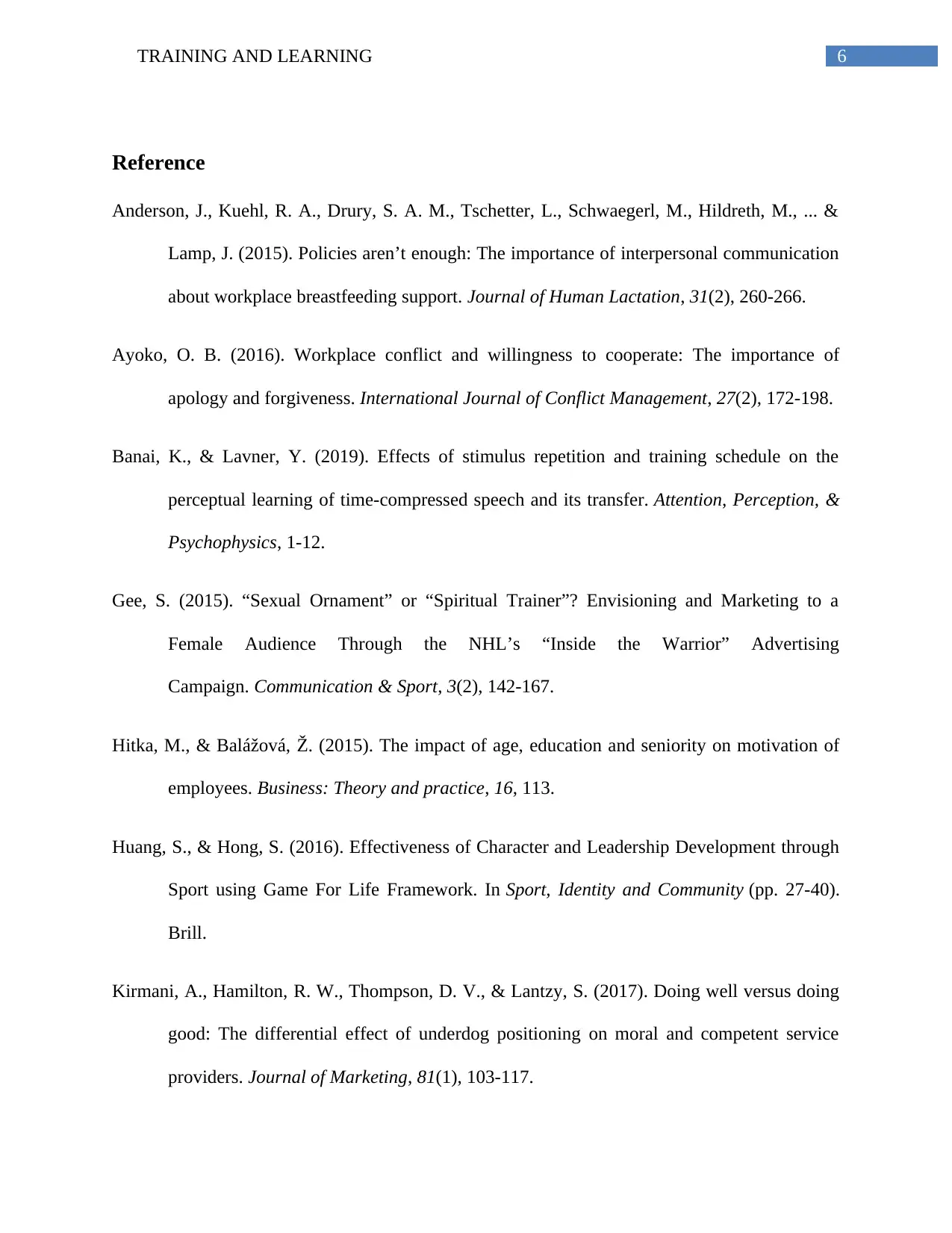
6TRAINING AND LEARNING
Reference
Anderson, J., Kuehl, R. A., Drury, S. A. M., Tschetter, L., Schwaegerl, M., Hildreth, M., ... &
Lamp, J. (2015). Policies aren’t enough: The importance of interpersonal communication
about workplace breastfeeding support. Journal of Human Lactation, 31(2), 260-266.
Ayoko, O. B. (2016). Workplace conflict and willingness to cooperate: The importance of
apology and forgiveness. International Journal of Conflict Management, 27(2), 172-198.
Banai, K., & Lavner, Y. (2019). Effects of stimulus repetition and training schedule on the
perceptual learning of time-compressed speech and its transfer. Attention, Perception, &
Psychophysics, 1-12.
Gee, S. (2015). “Sexual Ornament” or “Spiritual Trainer”? Envisioning and Marketing to a
Female Audience Through the NHL’s “Inside the Warrior” Advertising
Campaign. Communication & Sport, 3(2), 142-167.
Hitka, M., & Balážová, Ž. (2015). The impact of age, education and seniority on motivation of
employees. Business: Theory and practice, 16, 113.
Huang, S., & Hong, S. (2016). Effectiveness of Character and Leadership Development through
Sport using Game For Life Framework. In Sport, Identity and Community (pp. 27-40).
Brill.
Kirmani, A., Hamilton, R. W., Thompson, D. V., & Lantzy, S. (2017). Doing well versus doing
good: The differential effect of underdog positioning on moral and competent service
providers. Journal of Marketing, 81(1), 103-117.
Reference
Anderson, J., Kuehl, R. A., Drury, S. A. M., Tschetter, L., Schwaegerl, M., Hildreth, M., ... &
Lamp, J. (2015). Policies aren’t enough: The importance of interpersonal communication
about workplace breastfeeding support. Journal of Human Lactation, 31(2), 260-266.
Ayoko, O. B. (2016). Workplace conflict and willingness to cooperate: The importance of
apology and forgiveness. International Journal of Conflict Management, 27(2), 172-198.
Banai, K., & Lavner, Y. (2019). Effects of stimulus repetition and training schedule on the
perceptual learning of time-compressed speech and its transfer. Attention, Perception, &
Psychophysics, 1-12.
Gee, S. (2015). “Sexual Ornament” or “Spiritual Trainer”? Envisioning and Marketing to a
Female Audience Through the NHL’s “Inside the Warrior” Advertising
Campaign. Communication & Sport, 3(2), 142-167.
Hitka, M., & Balážová, Ž. (2015). The impact of age, education and seniority on motivation of
employees. Business: Theory and practice, 16, 113.
Huang, S., & Hong, S. (2016). Effectiveness of Character and Leadership Development through
Sport using Game For Life Framework. In Sport, Identity and Community (pp. 27-40).
Brill.
Kirmani, A., Hamilton, R. W., Thompson, D. V., & Lantzy, S. (2017). Doing well versus doing
good: The differential effect of underdog positioning on moral and competent service
providers. Journal of Marketing, 81(1), 103-117.
Paraphrase This Document
Need a fresh take? Get an instant paraphrase of this document with our AI Paraphraser
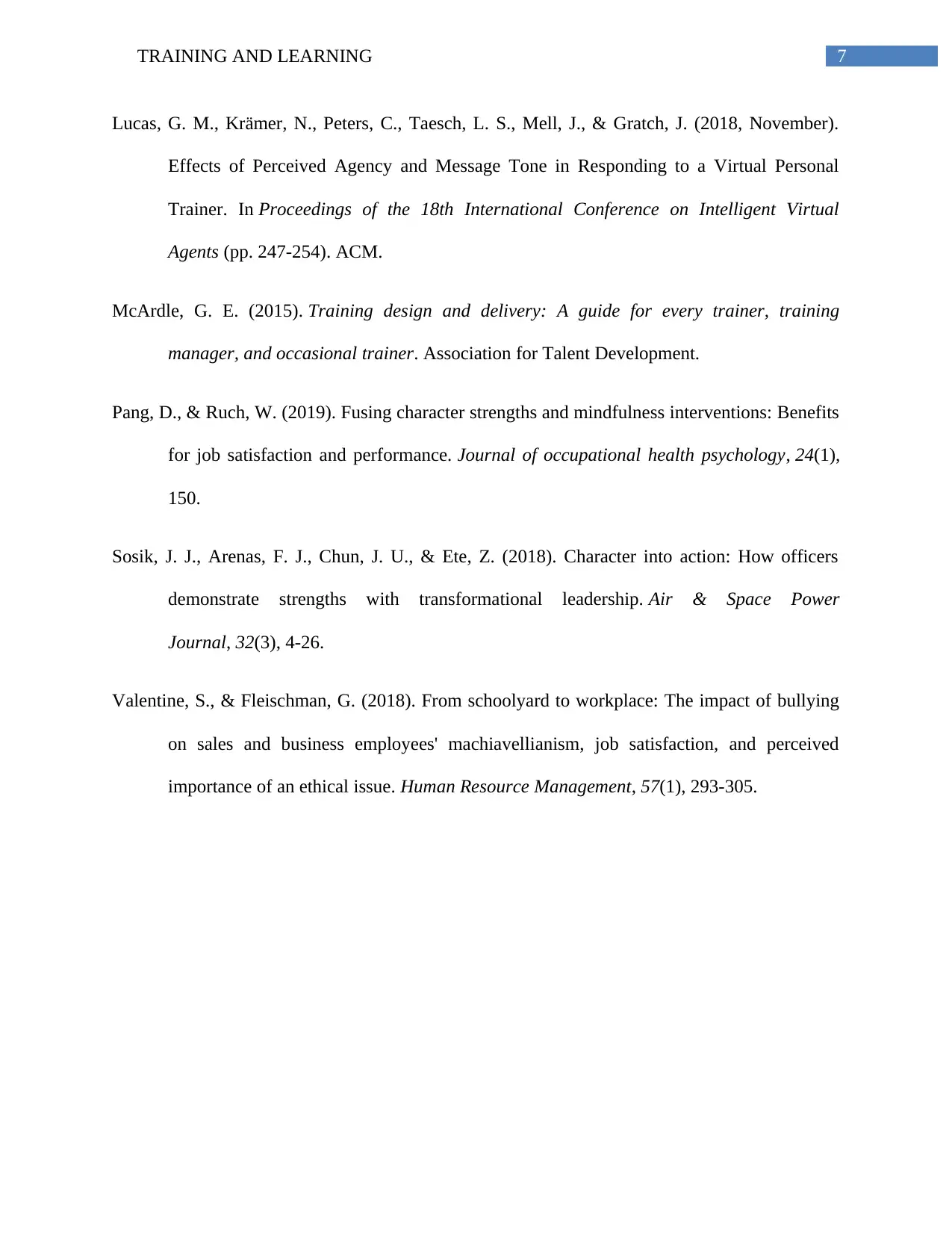
7TRAINING AND LEARNING
Lucas, G. M., Krämer, N., Peters, C., Taesch, L. S., Mell, J., & Gratch, J. (2018, November).
Effects of Perceived Agency and Message Tone in Responding to a Virtual Personal
Trainer. In Proceedings of the 18th International Conference on Intelligent Virtual
Agents (pp. 247-254). ACM.
McArdle, G. E. (2015). Training design and delivery: A guide for every trainer, training
manager, and occasional trainer. Association for Talent Development.
Pang, D., & Ruch, W. (2019). Fusing character strengths and mindfulness interventions: Benefits
for job satisfaction and performance. Journal of occupational health psychology, 24(1),
150.
Sosik, J. J., Arenas, F. J., Chun, J. U., & Ete, Z. (2018). Character into action: How officers
demonstrate strengths with transformational leadership. Air & Space Power
Journal, 32(3), 4-26.
Valentine, S., & Fleischman, G. (2018). From schoolyard to workplace: The impact of bullying
on sales and business employees' machiavellianism, job satisfaction, and perceived
importance of an ethical issue. Human Resource Management, 57(1), 293-305.
Lucas, G. M., Krämer, N., Peters, C., Taesch, L. S., Mell, J., & Gratch, J. (2018, November).
Effects of Perceived Agency and Message Tone in Responding to a Virtual Personal
Trainer. In Proceedings of the 18th International Conference on Intelligent Virtual
Agents (pp. 247-254). ACM.
McArdle, G. E. (2015). Training design and delivery: A guide for every trainer, training
manager, and occasional trainer. Association for Talent Development.
Pang, D., & Ruch, W. (2019). Fusing character strengths and mindfulness interventions: Benefits
for job satisfaction and performance. Journal of occupational health psychology, 24(1),
150.
Sosik, J. J., Arenas, F. J., Chun, J. U., & Ete, Z. (2018). Character into action: How officers
demonstrate strengths with transformational leadership. Air & Space Power
Journal, 32(3), 4-26.
Valentine, S., & Fleischman, G. (2018). From schoolyard to workplace: The impact of bullying
on sales and business employees' machiavellianism, job satisfaction, and perceived
importance of an ethical issue. Human Resource Management, 57(1), 293-305.
1 out of 8
Your All-in-One AI-Powered Toolkit for Academic Success.
+13062052269
info@desklib.com
Available 24*7 on WhatsApp / Email
![[object Object]](/_next/static/media/star-bottom.7253800d.svg)
Unlock your academic potential
Copyright © 2020–2025 A2Z Services. All Rights Reserved. Developed and managed by ZUCOL.

